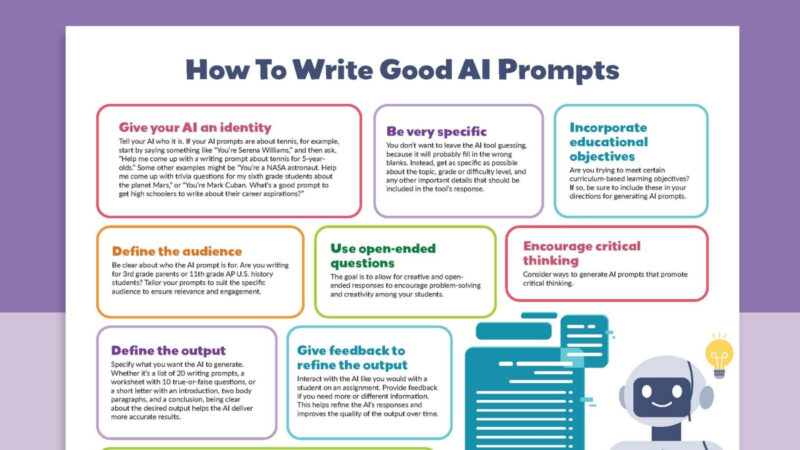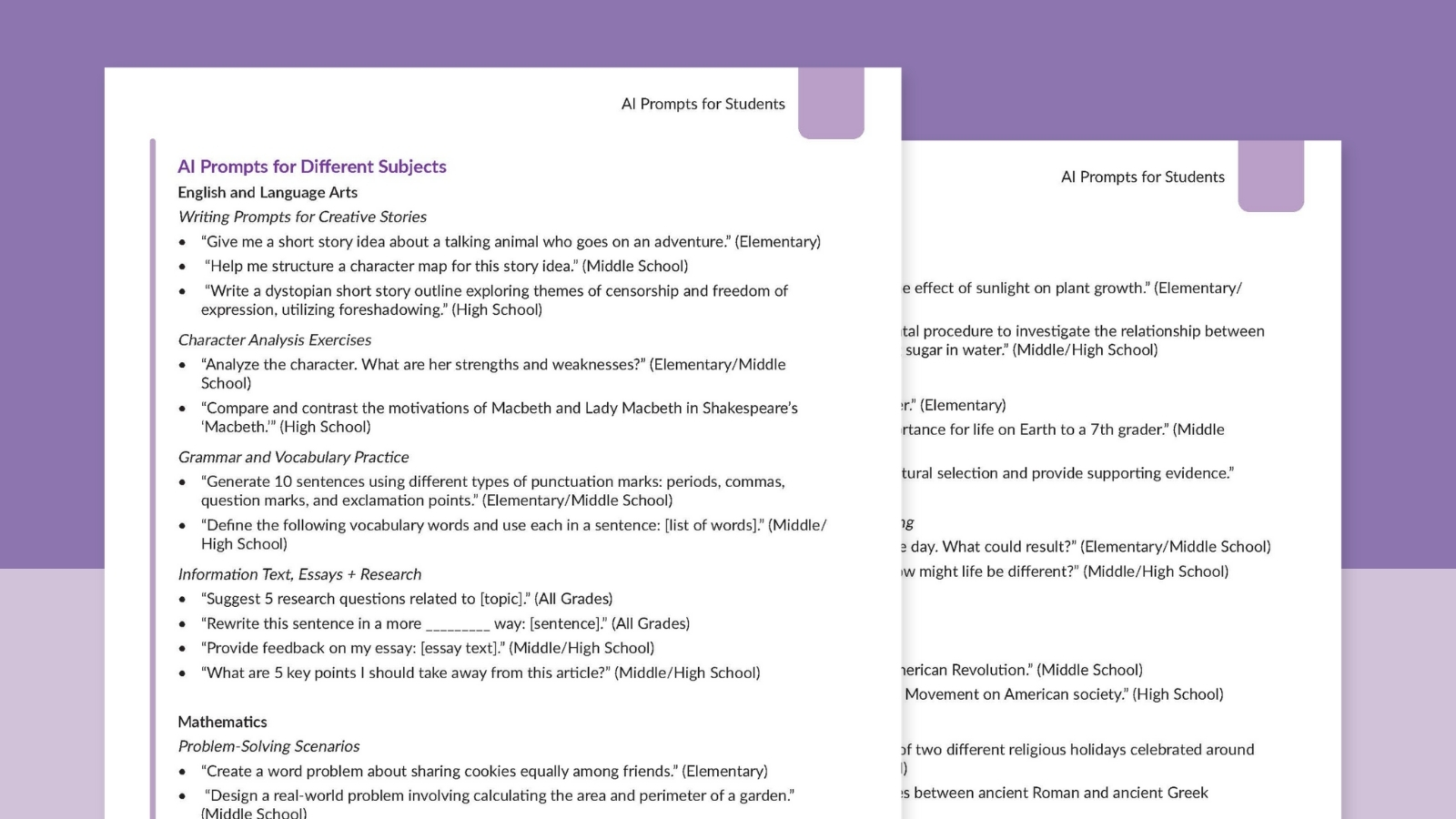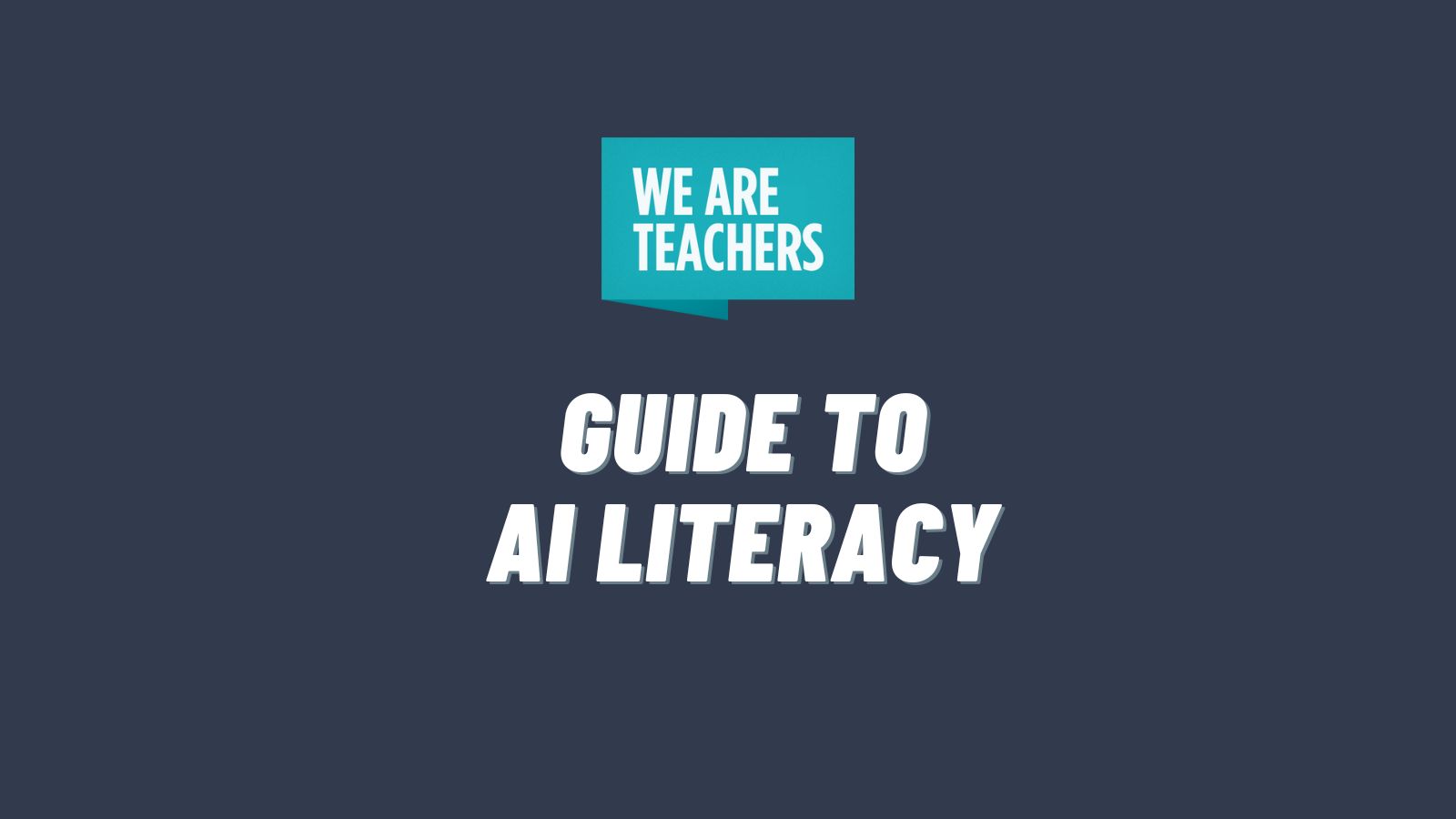As AI transforms every aspect of our lives, equipping students with AI literacy is no longer a choice—it’s a necessity. This critical skill set empowers students to understand, evaluate, and interact with AI technologies, preparing them for a future where AI is ubiquitous. Just as smartphones have become indispensable, AI is here to stay, and classrooms must adapt. According to Jennifer Womble, Chair of the Future of Education Technology Conference (FETC), “teaching AI literacy equips students with future-ready skills, enhances critical and creative thinking, and fosters responsible digital citizenship.”

FREE PRINTABLE
AI Prompts for Students
We’ve compiled a list of AI prompts for students, plus tips on how to write AI prompts, into an easy-to-print handout for students.
What is AI literacy?
AI literacy empowers students to:
- Understand how artificial intelligence works and its capabilities
- Think critically about and evaluate AI-generated content and its outputs
- Use AI tools responsibly and ethically
- Recognize potential biases and limitations of AI systems
- Consider the societal implications of AI technologies
Why teach AI literacy?
As schools navigate the integration of technologies like AI, it’s essential to move beyond addressing misuse and instead focus on educating educators and students on responsible use. By embracing AI literacy, schools can unlock its potential to enhance learning and prepare students for an AI-driven future.
“Instead of focusing on cheating, AI literacy empowers educators and students with knowledge on how to responsibly use AI tools to create engaging learning experiences,” says Womble. “Educators can leverage AI to personalize learning, while families gain awareness of ethical concerns like bias and privacy. By integrating AI literacy, schools can engage the stakeholders in change-making in the curriculum and technology tools with a broad understanding and support as they prepare students to engage critically, ethically, and effectively with AI. This ensures they can harness AI’s benefits while mitigating risks in an increasingly AI-driven world and future careers. The goal of leveraging AI in the classroom is to create time for more human interactions, elevating the teacher role as the instructor, coach, and mentor by having time to build relationships with students to support their learning and success.”
Teaching AI literacy is essential for several reasons:
- Future-proofing careers: AI is transforming industries, creating new job roles, and making other jobs obsolete. Understanding AI helps students prepare for the future job market.
- Enhancing problem-solving skills: AI literacy encourages critical thinking and data-driven decision-making.
- Informed citizenship: As AI impacts society in various ways, students need to be informed citizens who can contribute to discussions about its ethical use.
- Empowering creativity and innovation: Understanding AI allows students to leverage technology creatively in fields like art, science, and business.
AI Literacy Framework
“AI literacy for K-12 students and families is essential for navigating an AI-driven world and should include four pillars: understanding AI basics, recognizing AI’s strengths and limitations, ethical and responsible AI use and critical thinking, and media literacy,” says Womble. To effectively teach AI literacy, educators can use frameworks like the one developed by Digital Promise. This framework includes three key components:
- Understand: Acquire basic knowledge of AI capabilities and functioning
- Evaluate: Critically assess AI systems, their outputs, and societal impacts
- Use: Learn how to interact, create, and problem-solve effectively with AI tools
Strategies for Teaching AI Literacy
1. Get students acquainted with AI
Begin by introducing key AI concepts and definitions. Use engaging videos or interactive activities to spark curiosity. Some resources include:
2. Get hands-on with AI
Engage students with practical AI experiences:
As schools begin to teach AI literacy, the question will arise: How can educators effectively assess students’ AI literacy skills, given the rapidly evolving nature of AI technology?
“To assess AI literacy effectively, educators should prioritize application-based evaluations. As educators have done with digital literacy leveraging project-based assessments, showcase students’ critical and creative thinking skills that are future-proof,” says Womble. “Performance-based tasks, like using AI tools and reflecting on their limitations and differences between tools, reinforce practical understanding. Inquiry-based research, designing digital portfolios, and gamified AI challenges can all engage students in real-world problem-solving. Classes can host ethical debates to test reasoning skills and build the communication skills needed in future careers. By using diverse, hands-on assessments embedded in the curriculum, educators ensure students develop AI comprehension, critical analysis, creativity, and ethical awareness—equipping them to navigate and apply AI technology responsibly in an evolving digital landscape.”
3. Get critical about AI
Encourage students to get critical and evaluate AI-generated content:
- Analyze images, text, or videos with students to determine if they’re AI-generated or human-created. (This can be fun!)
- Discuss some biases in AI systems and the societal implications of AI-generated content.
- Explore ethical considerations of AI use in various contexts like news, social media, and schoolwork.
4. Get contextual about AI
Show students how AI literacy connects to school subjects:
- In ELA, analyze AI-generated writing and discuss authorship. Discuss how AI is a tool and does not replace the art and craft of writing.
- In social studies, explore the impact of AI on jobs and society. Debate the ethical implications of AI in government decision-making, such as privacy concerns and bias in AI-driven policies.
- In science, learn how AI is used to analyze large datasets in scientific research, helping students understand AI’s role in discovery and experimentation.
- In math, integrate AI by using machine learning algorithms to solve mathematical problems or analyze datasets, teaching students about AI’s role in pattern recognition and prediction.
- In art, explore how AI can generate art and design elements, discussing the intersection of creativity and technology.
- In computer science, teach programming skills using AI tools, focusing on ethical coding practices and responsible AI development.
5. Model responsible AI use
Demonstrate how to use AI tools ethically and effectively in the classroom. Show students how to:
- Verify information from AI sources
- Properly cite AI-generated content
- Use AI as a tool to gather ideas and enhance, not replace, critical thinking or writing
More Resources for Teaching AI Literacy
Lesson plans and curricula
Additional resources
Events
FETC AI Literacy Webinar
FETC Conference 2026
ISTELive 25 + ASCD Annual Conference, June 29 to July 2, 2025
Get your AI prompts printable!

Download and print out our free handout with all of the AI prompts your students will need to succeed using AI.

